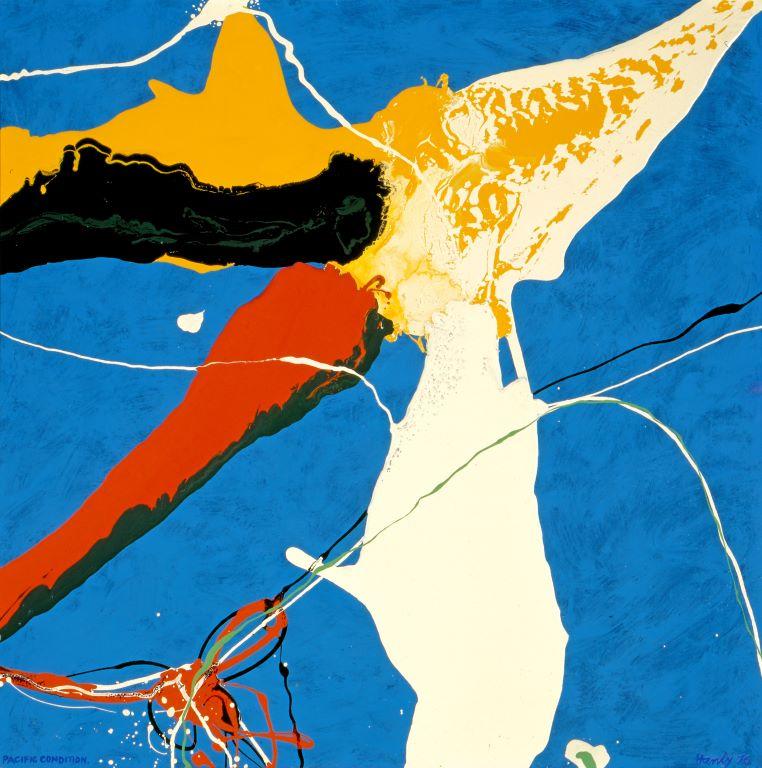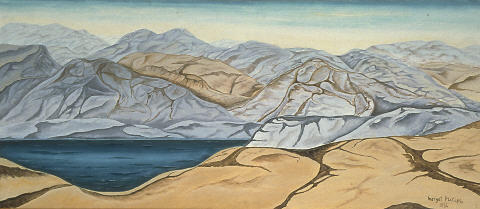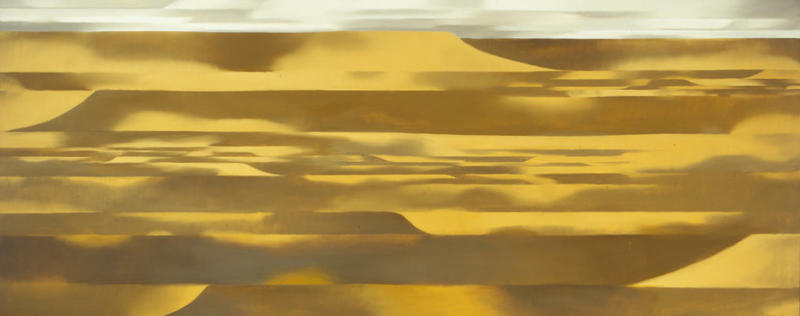Leaps and Boundaries | William McAloon in conversation with Rob Gardiner (1998)
5 April 2020

Pacific Condition by Pat Hanly (1976), Chartwell Collection, Auckland Art Gallery Toi o Tāmaki, 1977
Originally published in ed., William McAloon, Home and Away: Contemporary Australian and New Zealand Art from the Chartwell Collection, Auckland Art Gallery Toi o Tāmaki, 1999.
William McAloon: I think the best place to begin is to ask you twenty- five years after you made your first acquisition for the Chartwell Collection, did you imagine then that you'd be here now with a collection of international significance, numbering nearly 600 works?
Rob Gardiner: Well I can remember speculating about this, thinking into the future. I could see that there could be some exciting things that might happen. I did used to dream about that, it was a dream that probably started about thirty years ago really, and the Collection then started as you were suggesting, about twenty-five years ago. But the Chartwell Trust project came out of a desire to solve a problem that was there at the time in Hamilton, which was that we didn't have an art gallery. I couldn't see how one was going to be paid for, and so right from the start the Collection was shaped by this. I had a vision for it as a community project. That's why we set up Chartwell as a charitable trust.
The Collection itself didn't start until after the original investments were made by the Trust and some years had passed so that I could begin to see that if all went well, there would be significant resources available to achieve the goal, although at the time, that goal was to pay for an art gallery. And I can remember thinking that it might take my lifetime. In the event, for various reasons, the city paid for the museum. But when the Chartwell Trust started, the dream was to help build an art gallery.
Where did your interest in art first come from and when did it first emerge?
It comes from being a part-time art-maker. I am a bit hesitant to deal with that, but making work is and was then a real source of energy and passion. I'd been drawing since school days and after I’d qualified as an accountant, I got more into that by going along to evening classes weekend workshops and adult education: all the usual things that a local artist would do, exhibiting and generally having - I was going to say fun, and it was fun, but it was also a serious engagement. I came to learn a lot by observing other people and what they were making. And I was already visiting Auckland. There were the early dealer galleries: the New Vision Gallery, Barry Lett Galleries, Ikon Gallery in Wellesley Street. In and out of Auckland I was already meeting artists and learning. That was important by way of the establishment of the Trust because they were supportive of me even at that early stage. Pat Hanly, for example, and Margot Philips the Waikato artist.
Was art seen as an unusual activity for you to be involved in?
I suppose that for some people it seemed unusual given that my profession was accountancy and it didn't seem to have any natural connections to art. But my professional life as an accountant was important to the financial planning strategies that I had to put in place to buy a business as an investment for the Trust.
Where did your interest in this kind of community activity come from?
I’ve always thought that I inherited from my father an interest in community things. He had been a Rotarian and I was, back in those years, pretty active in the Jaycees, a local group of generally young business people with a sense of community spirit and they'd been involved in a number of community projects over the years in Hamilton.

South Island I by Margot Philips, (1973), Chartwell Collection, Auckland Art Gallery Toi o Tāmaki, 1977

Threshold VIII by William A Sutton, (1973), Chartwell Collection, Auckland Art Gallery Toi o Tāmaki, 1974
The Waikato Museum and Art Gallery as it was then called was important for the Collection from quite early on, wasn't it?
It was across the road from my office and I can remember the first major acquisitions for the Chartwell Collection, paintings by W. A. Sutton and Pat Hanly, going directly into the museum's storage. Even from that early stage, I was very clear about it not being a personal collection. The idea was that one should think as a trustee, think that the work belongs to other people and that it was being bought for public use. The name Chartwell was in a sense part of that strategy. I was looking for a nom-de-plume. I wanted it to be in a sense anonymous. Our family lived in the Hamilton suburb of Chartwell at the time so the name Chartwell came from there.
So that was always the basis of the Chartwell Collection, it was never something that you bought to put on your own walls at home? It's quite unusual for a collector to have begun in that manner. A lot of collections have ended up like that, but not begun with that intention.
It's interesting that you should say that because I was by then vaguely aware of the great American collections - the Rockefellers, the Lannans - people who had set up huge foundations, but I couldn't see that happening in New Zealand.
Up until that time there hadn't been a lot of art collecting in New Zealand. There were a few individuals collecting, and some corporate collections developing.
It was a time when collections were beginning to start. Of course, there had been the collecting activity within the public institutions, and that had set standards in collecting practice. But that was quite limited by the availability of funds. There had been a few private collections given to museums.
Under that American example, a person could generate great wealth in their lifetime and develop a great collection, then die or, sometimes for tax reasons, set up gifts to institutions. But I could see that what happens here was different, that our tax structures here don't allow that.
From the start, were you making the decisions yourself about what was going into the Collection?
I can remember an early conversation with Campbell Smith, who was Director of the Waikato Museum and Art Gallery, about where I was going. I was already feeling the responsibility and testing with him whether my system was satisfactory or not. He encouraged me to make my own decisions and to proceed on that basis, and that was important to me, but it put the responsibility on me to learn even more about art. Within the time I had available I was trying to upskill myself, getting to see shows in Auckland. There weren't many catalogues around in those days, but the influences were from within the museum system and the emerging dealer system. So the dealers became important right from an early stage. That Sutton was interesting because it was actually bought from a show in the Waikato Museum. I mention that because there are not many works in the Collection that weren't bought through dealers. Being in Hamilton I needed the support of dealers and that really worked well for me because I could make prompt decisions and I'd make the effort to go and see the work if they called. That process has been necessary for buying in Australia as well.
Buying Australian work was an unusual thing for a New Zealand collector then, and still is to some extent. How did this come about?
There were a number of things that came together there. About that time the government lifted the constraints on New Zealanders acquiring overseas currency. In the earliest stages I had to apply for funds to buy in Australia, but those restrictions came off soon after. But there were other things beginning to happen between New Zealand and Australia as well. The whole process of coming together economically and socially was occurring by that stage, with Closer Economic Relations. Up till then I think New Zealand looked directly to Britain, and Australia did the same. We both looked to the same place, but the business of looking at each other really only just started about that time.
How did the Centre for Contemporary Art come about?
Campbell Smith left the Museum and a new director took over and there wasn't the relationship there that I had with Campbell. It came to a point where he phoned me one day and said, 'Look, you're buying too many works that are too large and we haven't got storage for them, so you have to solve your own storage problem and take them away.' So, that impacted on how I collected, because the nature of the Collection required a place to store things right from the start. They weren't at home.
Can I just say here, because people sometimes do ask me about what we have at home, that Ev and I had been buying work for ourselves. There were early things bought from galleries in Auckland, mainly works on paper. But our ability to buy for ourselves was quite limited. We could only afford prints for a while, and those prints are still there. And other bits and pieces too, bought from local artists. That's pretty much what's still on our walls at home. Ev has always been involved in art as well, and has been a great supporter to me.
So coming back to the problem of where to go. The Chartwell Trust bought a property, an old hotel, motivated by the need to have a storeroom. This was a major development and certainly solved the problem for quite a long time and this prompted a different vision for the Collection. It was going to have its own place. The Centre for Contemporary Art, which opened in 1982, was primarily considered for storage, but there was no point in just having it as an art store. It seemed to me we needed a place to exhibit the Collection as well. And we didn't just want the Collection there, so we started the whole programme of regular, imported shows.
And it's that time that marked a real acceleration of collecting for Chartwell.
Yes, in a way it did. All of this reflects the increasing resources available as we reduced debt from our business ventures and so on. The other impetus was to show new acquisitions annually in the Centre and I think that was a bit of a factor for developing the Collection. I occasionally bought from our own shows and had in place a contract for each artist with clauses that provided for the possibility of purchasing their work, where if there was a commission payable to a dealer, that was protected, so that I wasn't going to upset the dealers. And yes, the Collection grew during that period, a period of about twelve years.
This is when some of the definitive works of the Collection were acquired. The process had started a bit earlier on, with the purchase of McCahon's May His light shine, from his last show in Auckland at Peter Webb Galleries in 1980. But from the early eighties on, you're buying people like Tony Fomison, Don Driver, Arthur Boyd, Roger Kemp, and so on...
When I look back upon it, each purchase involved coming to an understanding. It wasn’t just bought for the sake of buying. What happened was I would come to understand the practice of the artist and the particular work, and this is still so for me. And these were people I came to know as well, people like Pat Hanly, Robert Ellis, Mary McIntyre, Jeffrey Harris... It's not really very methodical, you know, the buying. It's just reflecting my own learning at the time. Meeting dealers, meeting artists and coming to know their works and then having the confidence and interest to buy them. It's all part of a process.
I've always thought that as a viewer, in this case a collector, you're involved in what is essentially a creative act. It's your own vision of something which gives you a new understanding and you've invested time and knowledge in that process. So I do think of each act of purchasing a work as a creative act and of the Collection - as the cumulative effect of creative acts - as a statement itself.
What is apparent is the different layers that are in the Collection, for example that it has been sometimes been characterised as having an expressionist quality.
That's been a bit unfortunate because the Collection is much richer than that, as you know. It was something that started very early on, when someone had asked me about the Collection. I think I talked about mark-making and that was interpreted as meaning expressionist and it got into some publication and that was that.
What are some of the other strands in the Collection, other similarities and differences you see between New Zealand and Australia?
Well, one is the influence of indigenous art and this has been very important in both places. I'd draw a very general conclusion here about the discipline of Maori art as compared with Aboriginal art, which is much more painterly. That became clear to me when I was travelling in Australia, seeing the influence of Aboriginal art on people like Tuckson and Fairweather. I still get a huge charge out of their work, and how they'd looked to Aboriginal art and taken lessons from it, but I also get a huge charge out of Aboriginal art itself. Emily Kngwarreye, for example; she's a major artist.
But what is wonderful about New Zealand is the depth of thought of artists here, the solid grasp of the philosophical nature of art activity. I suppose we have some denial of colour here. There was all this abstract expressionist and colour field painting in Australia, but there wasn't much colour here. I remember travelling and coming back here and seeing that it's such a dark place. It's subtemperate and the winters are long, and we are shaped by this. People used to talk about the New Zealand light, but I think of it as both light and darkness. And that translates into our interest in white on black. I think we're very alert to tones here and so not into colour as the Australians are.
So what goes into making an acquisition?
In the end you're on you[r] own and you're just honest with yourself. And that was how Aboriginal art impacted on me. It was the same with Papua New Guinean art. I remember going to Sydney and seeing it for the first time and it amazed me and still does. And another thing was that it was unsigned - the notion of the original maker didn't matter. So there are a few Papua New Guinean pieces in the Collection, and now some Pacific tapa as well.
It is fair to say though that I haven't bought many people without a history, and I haven't always bought younger artists. I had gone to Australia I and I remember thinking, 'How far back should I buy?' I had decided to buy living artists so I thought, 'Well I could buy Boyd, I could buy Nolan,' because they were still alive. Roger Kemp was another interesting one. There was a generation there, of older artists who were still alive and still working, and I was buying their works. What I'm saying is that I wanted to 'buy back' a little bit, but not buy historically.
It's important to be recognised by dealers as being a sincere and knowledgeable buyer for the Collection. On my first visit I had to not so much buy works, but identify myself to certain individual dealers. And under pressure of time - and I smile thinking about this - I'd jump in a cab and race around the galleries and start talking. By then I was fairly experienced in the dealer environment and knew that it was a two-way gate. I’m very alert to how much a dealer knows and how much they pick up on what you say. You have to be able to go around and say something intelligent about a work. It's the way they judge you. And I think I've passed the test a few times.
What comes back to me looking through the Collection is the opportunities that it's given you to pursue particular interests, to pursue...
Personal passions.
Yes, personal passions. That's something that comes through very strongly.
It's also driven both by the public nature of the project and by my own expanding knowledge of practice over time. It seems to me that if you're not constantly open to learning, then you're not getting as much out of the project as you might. You discover new areas of interest all the time, and you're always discovering. And this is reflected in the Collection.
Auckland, 29 October 1998
